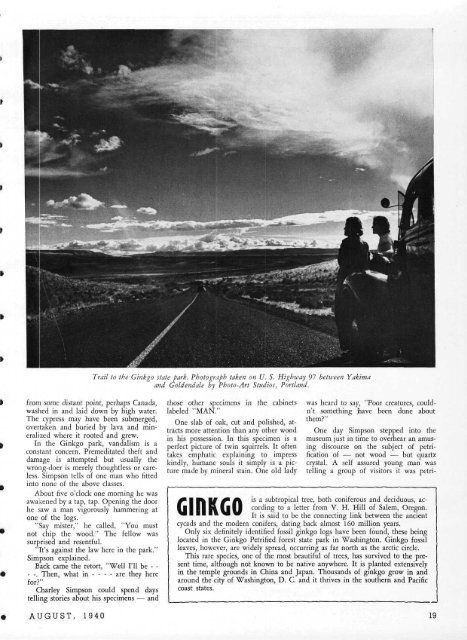M A G A N E - Desert Magazine of the Southwest
M A G A N E - Desert Magazine of the Southwest
M A G A N E - Desert Magazine of the Southwest
Create successful ePaper yourself
Turn your PDF publications into a flip-book with our unique Google optimized e-Paper software.
Trail to <strong>the</strong> Ginkgo state park. Photograph taken on U. S. Highivay 97 between Yakima<br />
and Goldendale by Photo-Art Studios, Portland.<br />
from some distant point, perhaps Canada,<br />
washed in and laid down by high water.<br />
The cypress may have been submerged,<br />
overtaken and buried by lava and mineralized<br />
where it rooted and grew.<br />
In <strong>the</strong> Ginkgo park, vandalism is a<br />
constant concern. Premeditated <strong>the</strong>ft and<br />
damage is attempted but usually <strong>the</strong><br />
wrong-doer is merely thoughtless or careless.<br />
Simpson tells <strong>of</strong> one man who fitted<br />
into none <strong>of</strong> <strong>the</strong> above classes.<br />
About five o'clock one morning he was<br />
awakened by a tap, tap. Opening <strong>the</strong> door<br />
he saw a man vigorously hammering at<br />
one <strong>of</strong> <strong>the</strong> logs.<br />
"Say mister," he called, "You must<br />
not chip <strong>the</strong> wood." The fellow was<br />
surprised and resentful.<br />
"It's against <strong>the</strong> law here in <strong>the</strong> park."<br />
Simpson explained.<br />
Back came <strong>the</strong> retort, "Well I'll be - -<br />
- -. Then, what in - - - - are <strong>the</strong>y here<br />
for?"<br />
Charley Simpson could spend days<br />
telling stories about his specimens — and<br />
those o<strong>the</strong>r specimens in <strong>the</strong> cabinets<br />
labeled "MAN."<br />
One slab <strong>of</strong> oak, cut and polished, attracts<br />
more attention than any o<strong>the</strong>r wood<br />
in his possession. In this specimen is a<br />
perfect picture <strong>of</strong> twin squirrels. It <strong>of</strong>ten<br />
takes emphatic explaining to impress<br />
kindly, humane souls it simply is a picture<br />
made by mineral stain. One old lady<br />
GinKGO<br />
was heard to say, "Poor creatures, couldn't<br />
something jhave been done about<br />
<strong>the</strong>m?"<br />
One day Simpson stepped into <strong>the</strong><br />
museum just in time to overhear an amusing<br />
discourse on <strong>the</strong> subject <strong>of</strong> petrification<br />
<strong>of</strong> — not wood — but quartz<br />
crystal. A self assured young man was<br />
telling a group <strong>of</strong> visitors it was petri-<br />
is a subtropical tree, both coniferous and deciduous, according<br />
to a letter from V. H. Hill <strong>of</strong> Salem, Oregon.<br />
It is said to be <strong>the</strong> connecting link between <strong>the</strong> ancient<br />
cycads and <strong>the</strong> modern conifers, dating back almost 160 million years.<br />
Only six definitely identified fossil ginkgo logs have been found, <strong>the</strong>se being<br />
located in <strong>the</strong> Ginkgo Petrified forest state park in Washington. Ginkgo fossil<br />
leaves, however, are widely spread, occurring as far north as <strong>the</strong> arctic circle.<br />
This rare species, one <strong>of</strong> <strong>the</strong> most beautiful <strong>of</strong> trees, has survived to <strong>the</strong> present<br />
time, although not known to be native anywhere. It is planted extensively<br />
in <strong>the</strong> temple grounds in China and Japan. Thousands <strong>of</strong> ginkgo grow in and<br />
around <strong>the</strong> city <strong>of</strong> Washington, D. C. and it thrives in <strong>the</strong> sou<strong>the</strong>rn and Pacific<br />
coast states.<br />
AUGUST, 1940 19

















